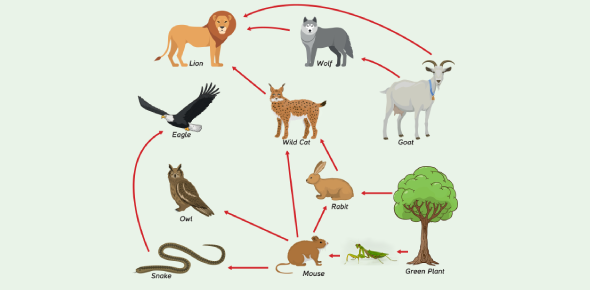What is the largest ecosystem in the world?
The Ocean
What is an ecosystem?
Community of interacting plants, animals, and their surroundings.
Explain the difference between producers and consumers.
Producers are organisms that make their own food from non-living materials.
Consumers eat other living things for energy.
What is an interrelationship?
A relationship between multiple things. In this case, relationships between multiple living things.
put the following in order, from smallest to greatest: organism, community, population, species, ecosystem.
Organism
Population
Community
Ecosystem
The best way to wipe out a species is to__?
Remove them from their natural environment.
What is the definition of a food chain?
a series of organisms that eat one another so that energy and nutrients flow from one to the next.
What is a scavenger and give me an example of one.
Scavenger: An organism that eats already dead animals.
Example: Hyena, Bear, Crab, Racoon, Vultures, Crows
Quickly create a 3 link food chain.
answers vary
For the food web below: What does the praying mantis represent?

A.A primary consumer.
B.A secondary consumer.
C.A tertiary consumer.
D.A producer.
E.A decomposer.
A. A primary consumer.
Name 4 extinct species
The Dodo Bird, Passenger Pigeons, Pearly Mussells, and Bighorn Sheep.
What factors impact an ecosystem?
Temperature, precipitation, geography.
List the order of the Energy Pyramid.
1. Sun
2.Producers
3. Herbivores
4.Omnivores
5.Carnivores
6. Decomposers
Describe a species
A group of similar organisms that can mate snd reproduce more of the same type of organism.
Which of the following organisms are examples of producers?
A.Plants and phytoplankton.
B.Plants and consumers.
C.Consumers and phytoplankton.
D.Phytoplankton and chlorophyll.
E.Phytoplankton and herbivores.
A. Plants and phytoplankton.
Name 2 types of ecosystems.
Deserts, and Savannahs.
What are the definitions of biotic and abiotic factors? Give an example of each.
Biotic are living things found in an environment.
Abiotic is non living components in an environment.
Biotic- Plants, animals, Funghi.
Abiotic-Water, soil, air, sunlight, temperature, and minerals.
What is Photosynthesis?
Is the process by which plants use sunlight, water, and carbon dioxide to create oxygen and energy in the form of sugar.
many overlapping food chains in an ecosystem.
Food Web
In order to survive, all living things need:
What is space, shelter, air (oxygen), food, and water
What are the 5 things you can do to increase biodiversity?
1. Recycle glass and paper from your home
2. Leave nature in nature, don’t bring things home from forests, tidepools, or deserts.
3. Plant trees
4.Stay on trails when hiking and riding your bike.
5. Don’t dump oil or gas solvents in storm drains, it hurts the ecosystem and the environment.
What is the difference between a community and a population?
Community- Groups of different populations of different types of species living in the same given area.
Population- Multiple individuals or a group of the same species living in the same area.
What is the difference between detritivores and decomposers?
Detritivores are organisms that feed on large parts of decaying plants and animal matters.
Decomposers are organism that consumes and breaks down dead organisms and waste matter into simple substances.
What are the three energy roles all organisms in the ecosystem fit into?
producers, consumers, and decomposers
Ecology is the study of the:
A.Abiotic parts of the environment, such as climate, air, and soil.
B.Biotic parts of the environment, such as animals and plants.
C.Interactions between organisms.
D.Interactions between organisms as well as the interactions between organisms and their environment.
D.Interactions between organisms as well as the interactions between organisms and their environment.